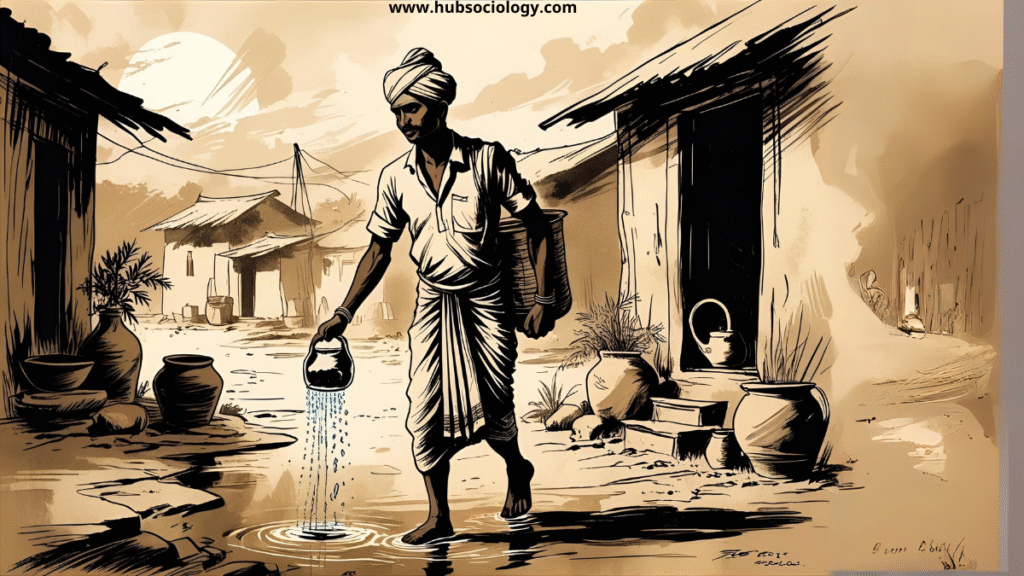Introduction on Jajmani System in Traditional Indian Society
The traditional Indian society was largely agrarian, community-oriented, and structured around caste-based interdependence. Within this social fabric, the Jajmani system emerged as a crucial institution that governed the economic and social relationships among various castes. It functioned as a form of hereditary patron-client relationship that ensured economic sustenance, occupational continuity, and social order in rural India. Sociologically, the Jajmani system reflected both the functional integration and hierarchical stratification of Indian village society.
Understanding Jajmani System in Traditional Indian Society provides deep insights into the nature of traditional Indian economy, social organization, and the persistence of caste-based roles.

Table of Contents on Jajmani System in Traditional Indian Society
Meaning and Origin of the Jajmani System
The term Jajmani is derived from the Sanskrit word Yajman, meaning a patron or one who sponsors a religious ritual. In the Jajmani system, the Jajman referred to the patron—usually a landowning upper-caste family—while the Kamin or Prajā referred to the service-providing caste. This relationship was hereditary, regulated by custom, and deeply rooted in the village social structure.
The origin of the Jajmani system can be traced to ancient India when occupational specialization became a hallmark of caste divisions. The Purusha Sukta of the Rig Veda symbolically described the social stratification of society, where each caste had specific functions. Over time, these occupational functions became hereditary, leading to a system where every caste depended on others for goods and services. This interdependence crystallized into the institutional form known as the Jajmani system.
Structure and Functioning on Jajmani System in Traditional Indian Society
The Jajmani system was a network of reciprocal services among different castes within the village. The Jajmans—mostly the upper and middle castes such as Brahmins, Rajputs, or large farmers—were the patrons who provided food, land, grain, or other forms of payment to the service castes. The Kamins—artisans and service providers like barbers, potters, blacksmiths, washermen, and sweepers—rendered essential services to the Jajmans on a permanent, hereditary basis.
Payments were not made in cash but usually in kind—grains, clothes, or other agricultural produce. The system ensured that each caste had an assured source of livelihood. For example, the barber received annual grain payments for his services, the potter supplied earthenware to the entire village, and the washerman collected clothes from all families and received grain during harvest seasons. Thus, the Jajmani system was not merely an economic arrangement but a social institution ensuring interdependence and stability in the village community.
Sociological Features of Jajmani System in Traditional Indian Society
From a sociological perspective, the Jajmani system exhibited several defining characteristics that reflected the structure of traditional Indian society:
- Hereditary Occupation:
Both rights and duties in the Jajmani system were hereditary. The occupation of each caste was passed from one generation to another, ensuring continuity and stability in the social structure. - Caste-Based Division of Labor:
The system was grounded in caste-based specialization. Each caste had a predetermined occupation, and members were expected to adhere to it without deviation. This reflected the functionalist dimension of caste as a system of social and economic organization. - Reciprocity and Interdependence:
The system created a network of mutual dependence. The landowning castes depended on service castes for essential goods and services, while the latter relied on patrons for economic security. This reciprocal exchange maintained the cohesion of rural society. - Non-Monetary Economy:
The Jajmani system primarily functioned on a barter basis. The exchange of services and goods was regulated by custom rather than by market forces, making it a pre-capitalist economic structure. - Stability and Continuity:
Since relationships were hereditary and regulated by tradition, the system ensured social stability and continuity in the village structure, although at the cost of social mobility. - Social Hierarchy and Dependence:
The system reinforced caste hierarchy. The lower castes were dependent on higher castes for livelihood, which perpetuated social inequality and status subordination.
Sociological Interpretations on Jajmani System in Traditional Indian Society
Several sociologists and anthropologists have studied the Jajmani system and interpreted its sociological significance in different ways:
- W.H. Wiser’s Functionalist View:
In his classic study The Hindu Jajmani System (1936), Wiser viewed the system as a functional and integrated institution that ensured the economic and social stability of the village community. He emphasized its role in maintaining inter-caste cooperation and the continuity of traditional social life. - Opler and Mayer’s Structural Perspective:
Anthropologists Marvin Opler and Adrian Mayer also emphasized the structural-functional role of Jajmani relations. They considered it a system that balanced rights and duties across castes, providing a stable framework for rural social organization. - Critical Perspective by Harold Gould and Others:
Later sociologists offered a critical perspective, highlighting that while the Jajmani system ensured interdependence, it also perpetuated inequality and caste-based exploitation. Lower castes were bound to serve the higher castes with little possibility of economic or social mobility. Gould described it as a system of “hereditary servitude” that functioned to maintain dominance of the upper castes. - Marxist Interpretation:
From a Marxist standpoint, the Jajmani system can be viewed as a form of pre-capitalist mode of production, where the relations of production were defined by social hierarchy rather than by ownership of means of production. The surplus labor of the lower castes was appropriated by the higher castes under the guise of tradition and duty.
Social and Economic Implications
The Jajmani system had both positive and negative implications for traditional Indian society.

Positive Aspects:
- Economic Security:
The system provided a form of social security to the artisan and service castes, ensuring a stable livelihood independent of market fluctuations. - Social Cohesion:
The interdependent relationships fostered social cohesion and mutual aid in the village community. It helped maintain order and collective functioning. - Occupational Continuity:
By preserving hereditary occupations, the system ensured skill transmission across generations, maintaining high levels of craftsmanship and service efficiency.
Negative Aspects:
- Caste Exploitation and Inequality:
The lower castes often faced exploitation under this system. Their labor was undervalued, and they were bound to serve their Jajmans without freedom to change occupation or negotiate compensation. - Lack of Mobility:
The hereditary and caste-based nature of the system restricted social and economic mobility. Occupations were rigidly fixed, leaving no room for individual advancement. - Resistance to Change:
The system was conservative and resistant to modernization. It hindered the growth of a free labor market and delayed the process of industrial and capitalist development in rural India.
Decline of the Jajmani System
The Jajmani system began to decline during the colonial period and further weakened after India’s independence. Several factors contributed to its disintegration:
- Introduction of Monetary Economy:
British colonial policies and the spread of a cash-based economy eroded the barter-based structure of the Jajmani system. - Land Reforms and Modernization:
Land reforms, increased mobility, and industrialization provided new economic opportunities, breaking traditional caste-based economic ties. - Education and Social Mobility:
The spread of education and the growth of urban employment opportunities enabled members of lower castes to escape hereditary occupations. - Legal and Political Changes:
Post-independence constitutional reforms abolished untouchability and promoted equality, undermining the caste-based patron-client relationships of the Jajmani system.
Conclusion on Jajmani System in Traditional Indian Society
The Jajmani system was one of the most distinctive institutions of traditional Indian rural society, reflecting both its interdependence and inequality. Sociologically, it illustrates how economic functions were embedded within the social and ritual hierarchy of caste. While it provided social stability and ensured the continuity of village life, it also perpetuated rigid inequalities and dependence. Its decline marked the transition from a traditional, caste-bound economy to a modern, market-oriented one.

In the broader sociological perspective, the study of the Jajmani system remains vital for understanding the evolution of Indian society—from a traditional, hierarchical structure toward a modern, egalitarian and industrialized order. It serves as a reminder of how social institutions, while functionally necessary in their context, can also embody deep-seated inequalities that societies must continually strive to overcome.
Do you like this “Jajmani System in Traditional Indian Society” Article ? You Can follow as on :-
Facebook – https://www.facebook.com/hubsociology
Whatsapp Channel – https://whatsapp.com/channel/0029Vb6D8vGKWEKpJpu5QP0O
Gmail – hubsociology@gmail.com
Topic Related Questions on Jajmani System in Traditional Indian Society
5 Marks Questions on Jajmani System in Traditional Indian Society (Short Answer Type)
- Define the Jajmani System.
- What is the origin of the term ‘Jajmani’?
- Mention any two main features of the Jajmani system.
- What is the role of the Jajman and the Kamin in the Jajmani system?
- How did the Jajmani system ensure economic security in traditional Indian villages?
- Name two sociologists who have studied the Jajmani system and briefly state their views.
- Explain the hereditary nature of the Jajmani system.
- What was the basis of payment in the Jajmani system?
- Write a short note on the decline of the Jajmani system.
- What is meant by “reciprocal relationship” in the context of the Jajmani system?
10 Marks Questions on Jajmani System in Traditional Indian Society (Short Essay Type)
- Discuss the main features of the Jajmani system in traditional Indian society.
- Explain the sociological significance of the Jajmani system.
- Describe the functional role of the Jajmani system in maintaining social order in Indian villages.
- Examine the advantages and disadvantages of the Jajmani system.
- Discuss the factors responsible for the decline of the Jajmani system in India.
- How did the Jajmani system reflect caste-based division of labour?
- Evaluate the Jajmani system as a form of traditional village economy.
- Explain W.H. Wiser’s contribution to the study of the Jajmani system.
- How did the Jajmani system contribute to both interdependence and inequality in rural society?
- Discuss the relevance of the Jajmani system in modern Indian villages.
15 Marks Questions on Jajmani System in Traditional Indian Society (Long Answer / Essay Type)
- Critically examine the Jajmani system as a form of social and economic organization in traditional Indian society.
- Explain the structure, functions, and sociological implications of the Jajmani system.
- Discuss the Jajmani system as an institution reflecting both cooperation and exploitation in Indian villages.
- Evaluate the functionalist and critical (Marxist) perspectives on the Jajmani system.
- Trace the historical evolution and decline of the Jajmani system in India.
- How did the Jajmani system reinforce caste hierarchy and social stratification? Discuss with examples.
- Examine the relevance of the Jajmani system in understanding the nature of rural social structure in India.
- Discuss the role of the Jajmani system in maintaining social equilibrium in the traditional Indian village.
- Compare the Jajmani system with other forms of patron-client relationships in agrarian societies.
- Critically analyze the view that the Jajmani system was both a system of mutual dependence and hereditary servitude.
